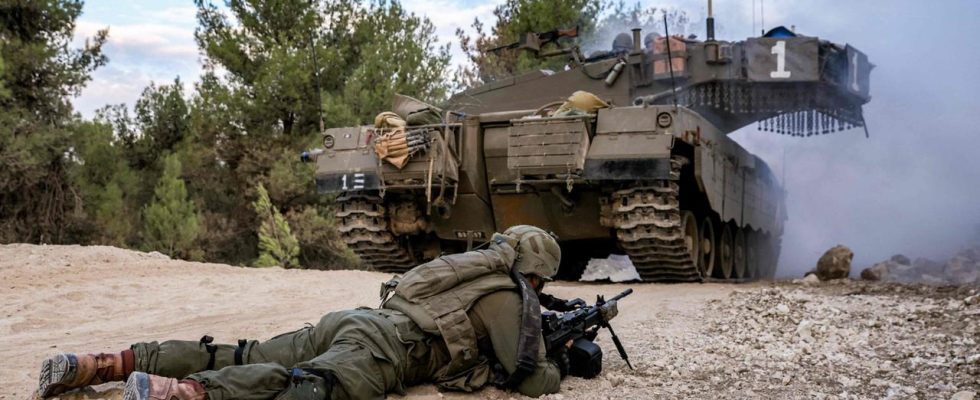interview
The division of the Gaza Strip is intended to prevent Hamas terrorists from escaping to the south, says military expert Gressel. In the interview he explains what this means for the civilian population and how long the war could last.
tagesschau24: According to the Israeli army, the Gaza Strip is now divided into two areas. What purpose does the division into north and south have for the Israeli army?
Gustav Gressel: The focus of Hamas’s infrastructure is believed to be in the north, i.e. in Gaza City. The Israeli army has now divided the Gaza Strip in two so that it can at least prevent Hamas’ infrastructure from escaping. Firstly, they want to destroy the infrastructure, but secondly they also want to either kill or capture important cadres, i.e. leaders and technicians in the weapons production facilities, in order to later exchange them for hostages.
They want to free the hostages as far as possible. From Israel’s perspective, it is important to prevent escape and transfer maneuvers by Hamas and its top personnel or the hostages. And that’s why the Gaza Strip was cut in two. However, the Israeli army announced this maneuver long in advance, and the question arises, especially when it comes to personnel, who are more mobile than infrastructure, how many of them have not already escaped to the south?
Escape to the south becomes even more difficult
tagesschau24: Will it now be easier for civilians to flee from the north to the south or will it be more difficult?
Gressel: Things were already difficult before the partition. It becomes even more difficult now because there is basically only one corridor that the Israeli forces control. Hamas wants to prevent civilians from being sent to the south because it needs the civilians as shields and can better carry out its brand of ambush tactics in an environment where there are both civilians and fighters on every corner.
There have also been previous attempts to prevent Palestinian civilians from fleeing to the south. From Hamas’s perspective, this is now easier if it only has to monitor access to this one corridor that the Israeli army keeps open to civilians, whereas previously significantly more Palestinian civilians were probably able to escape via small streets and backyards.
To person
Gustav Gressel is a Senior Policy Fellow at the European Council On Foreign Affairs in Berlin.
“Hamas needs dead civilians for its propaganda”
tagesschau24: The depressing images we see are images of ruins in Gaza. You can’t imagine that people still live there. What is the point of the Israeli army destroying so many houses?
Gressel: The Gaza Strip is essentially a large urban battlefield. There are town after town and town after town. In a local battle, houses provide cover and movement options, especially for infantry. You move in and through corridors of houses using cover against drones or the air force. There are well-developed positions in the basement and ground floors and good visibility from the roofs. That is, basically it is a position space.
If you fight this position, it will turn the houses into ruins. This is important in local battles because they would be evacuated if they were fought according to the rules of international war law. The Ukrainian army, for example, evacuates towns before they become battlefields so that there are no civilians left in the buildings. The problem with Hamas is that not only does it not do this, it also tries to stop it because it needs dead civilians for its kind of propaganda.
“Advance is slow”
tagesschau24: Let’s look at the actions of the Israeli troops on the ground. Hamas operates from tunnels. How is the Israeli army doing this?
Gressel: She goes slowly. How exactly the tunnels are located remains a secret. However, the Israeli army is technically prepared for such a scenario. You want to find the tunnels under the houses that you capture, then scout them out, so send squads down to see what’s in these tunnels and then blow them up.
This is very arduous work, and also grueling work for soldiers who do it. And that’s why the advance of the Israeli armed forces, especially from the north and east, is very slow, because you look house by house to see what’s hidden in the basement, where the tunnels are and then, before you move any further, these Tunnel systems scouted out accordingly.
“It’s not yet clear what happens afterwards”
tagesschau24: The Jerusalem Post reports today that the Israeli army has distributed combat equipment for the winter. Does that mean it will be a long conflict?
Gressel: The first military operation aimed at dismantling and arresting Hamas infrastructure and leadership will take a long time in itself. In recent weeks we have seen the slow progress of the Israeli army, which has to move house by house and block by block. And then it is still not clear what actually happens afterwards.
What kind of administration should be established after Hamas in the autonomous areas or in the Gaza Strip? Can it hold its own if it is used by Israel, or how will the Palestinian civilian population behave? This is still completely up in the air. In this sense, one must assume that this conflict will last much longer than just this winter.
The interview was conducted by Mikhail Paweletz for tagesschau24.

